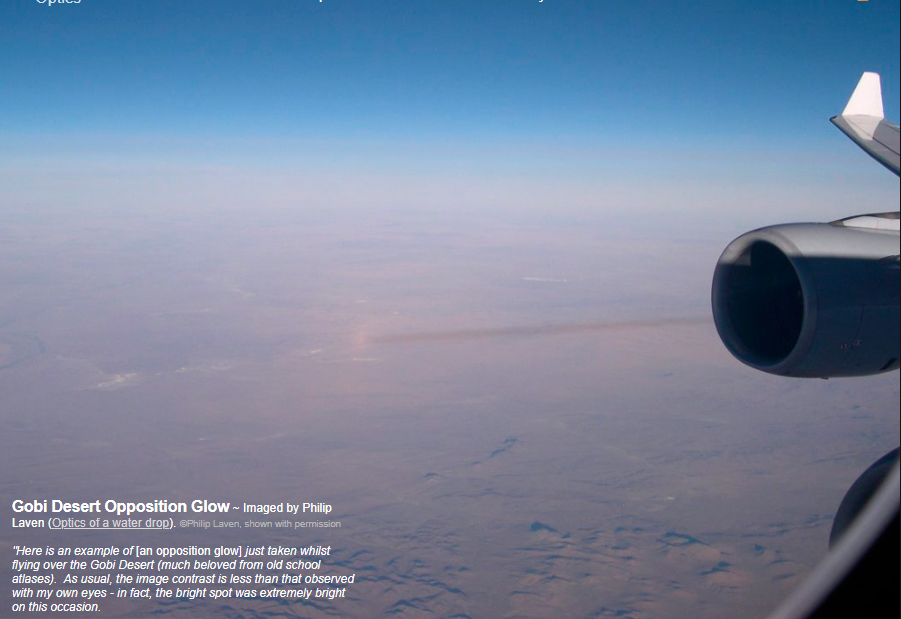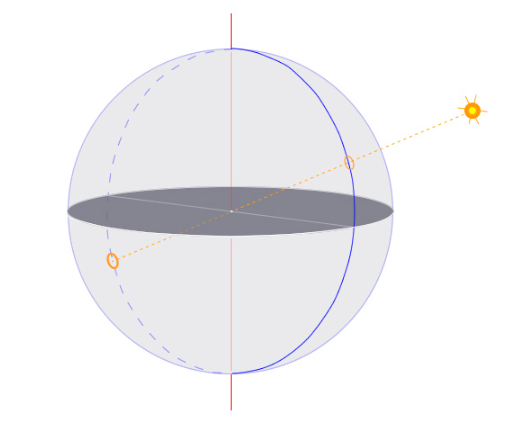Gobi Desert Glow
Gobi Desert Glow: A Fascinating Atmospheric Optics Phenomenon
The Gobi Desert, a vast and captivating expanse of land, has long been a subject of fascination for explorers, geographers, and photographers alike. Its stark beauty and unique features make it an ideal location for studying atmospheric optics phenomena. One such phenomenon is the "Gobi Desert Glow," an opposition glow that occurs when flying over this majestic desert.
The Marvelous Opposition Glow
Opposition glows are optical effects that appear at the antisolar point (ASP), which is the point directly opposite the sun in the sky. When observing the Gobi Desert from above, Philip Laven captured a stunning image of the opposition glow. The image, although less contrasted compared to what the naked eye perceives, showcased an exceptionally bright spot.
Identifying the Opposition Glow
To identify the opposition glow accurately, Philip Laven took great care while capturing the image. He used the orange-brown shadow of the aircraft's contrail as a reference point to mark the ASP. If you find yourself on the shadow side of an airplane, keep an eye out for the contrail shadow, as it can be followed for hours, slowly traversing across the landscape. Additionally, the directions of the dune shadows also serve as useful markers for identifying the ASP.
Unraveling the Bright Spot
The bright spot observed in the image is unlikely to be the center of a glory due to its small size. However, ice halos are occasionally seen around the ASP, resulting from the intersection of the subparhelic circle, diffuse arcs, and Parry antisolar arcs. In this particular case, there are no visible traces of other halo formations or cirrus clouds below the aircraft, making it improbable.
The Dry Heiligenschein: A Probable Explanation
In deserts like the Gobi, an atmospheric optics phenomenon known as the "dry heiligenschein" or "opposition glow" is often observed. While dew can occur in deserts, it is not the cause of this mesmerizing glow. The dry heiligenschein is best explained by shadow hiding caused by stones and soil, along with retroreflection by minerals and an effect called coherent backscattering. This combination of factors creates a captivating display of light and color.
Gobi Desert Glow: A Widespread Phenomenon
The Gobi Desert is not the only place where opposition glows can be observed. Similar phenomena have been documented on Earth, the Moon, Mars, and even asteroids. The unique geological characteristics of these locations contribute to the occurrence of opposition glows. For instance, shadow hiding by stones and soil, retroreflection by minerals, and coherent backscattering all play a role in creating these captivating optical effects.
Embracing the Wonder of Atmospheric Optics
The Gobi Desert Glow serves as a reminder of the awe-inspiring beauty and complexity of our natural world. It highlights the intricate interplay between light, atmosphere, and geological features. By studying and documenting these phenomena, we gain a deeper understanding of the Earth's atmosphere and its various optical properties.
As technology advances and more individuals have access to aerial perspectives, we can expect to witness and capture even more astonishing atmospheric optics phenomena like the Gobi Desert Glow. These captivating displays continue to inspire scientists, photographers, and nature enthusiasts around the world, encouraging us to delve further into the mysteries of our planet's atmospheric wonders.

Gobi Desert Opposition Glow ~ Imaged by Philip Laven (Optics of a water drop). ©Philip Laven, shown with permission
"Here is an example of .an opposition glow. just taken whilst flying over the Gobi Desert (much beloved from old school atlases). As usual, the image contrast is less than that observed with my own eyes - in fact, the bright spot was extremely bright on this occasion.
To make this a really "nerdy" occasion, I have decided to send it to you immediately via the aircraft's free WiFi." I opened my mail an hour after Philip took the picture but confess that it has taken a little longer to reach the OPOD screen.

There are so many optical effects at the antisolar point (ASP) that Philip took care with identification.
The orange brown shadow of the aircraft's contrail conveniently marked the ASP. Always look out for it if on the shadow side of an airplane. Sometimes the contrail shadow can be followed for hours slowly threading its way across the landscape. The directions of the dune shadows are other ASP pointers.
The bright spot is very unlikely to be the centre of a glory because it is too small.
Sometimes ice halos are seen around the ASP. The intersection of the subparhelic circle, diffuse arcs and Parry antisolar arcs forms a bright spot. However, cirrus below the aircraft is unlikely here and no other halo traces are visible.
A heiligenschein? Dew occurs in deserts but an 'opposition glow' or 'dry heiligenschein' is the best explanation.
Deserts on Earth, the Moon, Mars and asteroids exhibit opposition glows. Shadow hiding by stones and soil can make some contribution but there are additional ones from retroreflection by minerals and an effect called coherent backscattering.
Note: this article has been automatically converted from the old site and may not appear as intended. You can find the original article here.
Reference Atmospheric Optics
If you use any of the definitions, information, or data presented on Atmospheric Optics, please copy the link or reference below to properly credit us as the reference source. Thank you!
-
<a href="https://atoptics.co.uk/blog/gobi-desert-glow/">Gobi Desert Glow</a>
-
"Gobi Desert Glow". Atmospheric Optics. Accessed on April 19, 2024. https://atoptics.co.uk/blog/gobi-desert-glow/.
-
"Gobi Desert Glow". Atmospheric Optics, https://atoptics.co.uk/blog/gobi-desert-glow/. Accessed 19 April, 2024
-
Gobi Desert Glow. Atmospheric Optics. Retrieved from https://atoptics.co.uk/blog/gobi-desert-glow/.